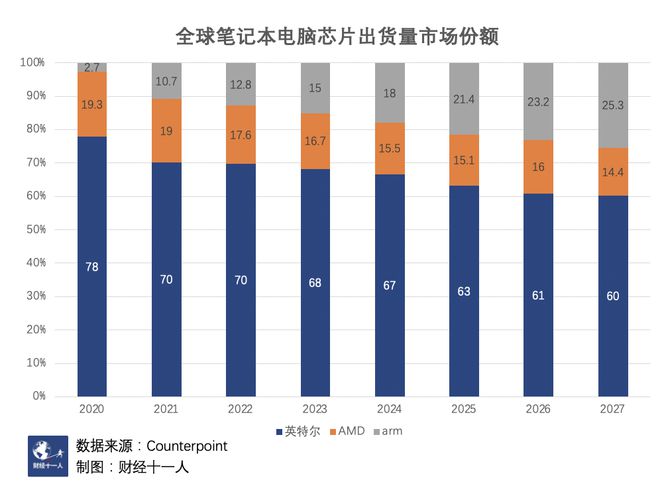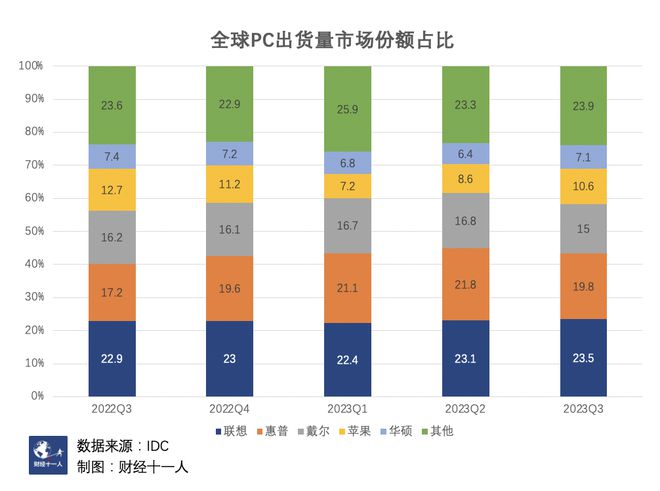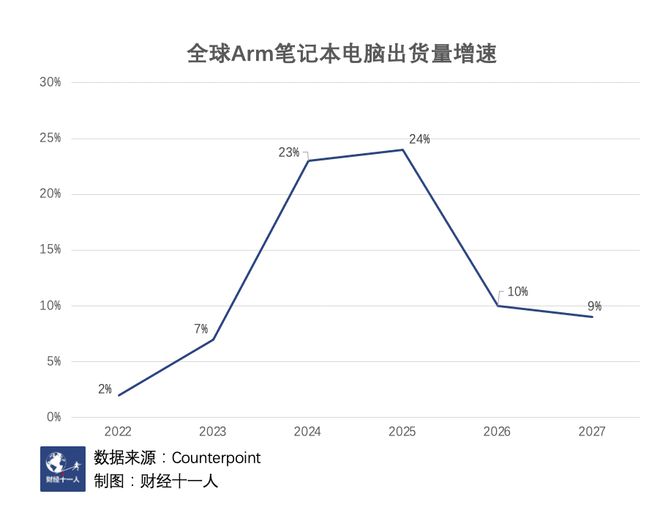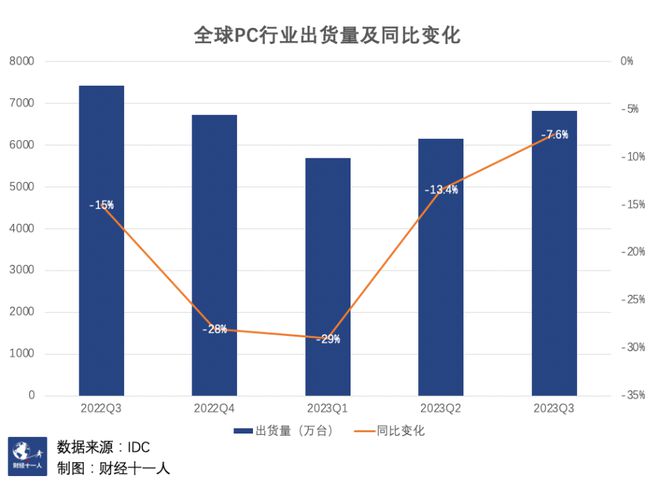The global computer market is undergoing changes, and ARM architecture and AI are catalysts
By 2027, the share of ARM architecture chips in the PC market is expected to be 25.3%, nearly doubling from 2022

By 2027, the share of ARM architecture chips in the PC market is expected to be 25.3%, nearly doubling from 2022. The share of x86 architecture will decline to 74.4%, but it will still maintain a significant lead

Wen | Liu Shuqi
Editor | Xie Lirong
The x86 architecture personal laptop (PC) market, led by Intel, is facing a new group of competitors.
At the Snapdragon Summit in 2023 from October 24th to 26th, American chip company Qualcomm released the ARM based PC chip "Snapdragon XElite", which also gave way to PC chips as the previous protagonist in mobile phones.
In the past, Qualcomm has also released Snapdragon 7c, 8c, and 8cx third-generation PC chips, but the response has been mediocre. This time Qualcomm is named after a new sequence because XElite is equipped with a new CPU core called Oryon.
Qualcomm CEO Amon stated that OryonCPU's single core performance surpasses Apple M2Max by nearly 14%, with a 30% reduction in power consumption; Compared to Intel's flagship chip, the Core i9-13980HX, it reduces power consumption by 70% with similar performance. PC products equipped with Snapdragon XElite are expected to be launched in mid-2024. In addition, OryonCPUs are expected to enter the automotive and XR terminals next year.
OryonCPU's technology mainly comes from Nuvia, a startup acquired by Qualcomm in 2021, founded by three former Apple chip design executives. This acquisition was also seen as a major layout for Qualcomm in the PC industry at the time.
Not just Qualcomm, according to media reports recently, NVIDIA and AMD are also developing PC chips based on Arm architecture, which are expected to be released as early as 2025.

This means that the PC industry's pattern dominated by Intel and x86 will loosen. There are two main camps for PC chips, x86 architecture and Arm architecture. The former is mainly owned by Intel and AMD, while the latter is owned by Apple. According to data from market research firm Counterpoint, in 2022, Intel and AMD respectively accounted for 70% and 17.6% of global PC shipments, while Arm's share was 12.8%.
From the perspective of market structure, Qualcomm's group of chip manufacturers entering the ArmPC market are collaborating with Windows, and their customers are computer companies using x86 architecture chips. Therefore, compared to Apple, which has its own macOS operating system and M-series chips, they directly threaten the territory of "Big Brother" Intel.
Counterpoint predicts that as more chip manufacturers launch ARM architecture PC chips, the market share of ARM architecture is expected to increase. By 2027, the share of ARM architecture chips in the PC market is expected to be 25.3%, nearly doubling from 2022; The overall share of x86 architecture will decline to 74.4%, with Intel's share dropping to 60%, but it will still maintain a significant lead.
Microsoft, Honor, Lenovo, Dell, and HP have all announced that they will launch computers equipped with ARM architecture chips next year. Honor CEO Zhao Ming commented to a reporter from Caijing that the computer industry x86 has been developing for many years, and the emergence of the Arm ecosystem will give the entire industry a new opportunity to evaluate which direction is more in line with the needs of the times and the market.


Can Arm challenge x86?
The origin of x86 and Arm dates back to the last century. In 1978, the Intel x86 architecture was introduced along with the 8086 processor, gradually becoming synonymous with personal computer CPUs and creating a huge commercial empire for Intel.
Due to complex historical reasons, AMD is the only company authorized by Intel to produce x86 architecture chips, which has also created a strong position in the PC chip industry for these two companies for a long time.
In the 1980s, the British company Acorn (the predecessor of Arm) designed ARM architecture chips and attempted to run them on the PC side, but it was difficult to resist the dominance of x86 architecture at that time - until the rise of smartphones, ARM architecture found its comfort zone, and currently 99% of smartphones worldwide use ARM architecture.
For a long time thereafter, x86 was considered more suitable for PCs and servers, and Arm architecture was more suitable for mobile devices.
Apple has subverted this imagination. In 2020, Apple abandoned Intel chips and self-developed M1 chips based on ARM, achieving commercial success.
IDC Asia Pacific Research Director Guo Junli told Caijing that Apple's self-developed ARM architecture PC chip showcases the performance of Intel x86 chips. In the third quarter of 2020, ARM's market share in PC chips was only 2%, but after more than a year of selling ARM compatible M1Macs, ArmPC's share rose to 11%.
Compared to x86, Arm does have some relative advantages. The most outstanding performance is low power consumption. Under the same performance conditions, Arm's design can result in lower power consumption and longer battery life of the device. Applied to PCs, it means longer battery life, fanless design, and a lighter, thinner, and more portable appearance. When running large-scale software, x86 is prone to issues such as device overheating and short battery life, and the computer is also relatively heavy.
In addition, due to the promising prospects of Arm architecture in smartphones, wearable devices, smart homes, and smart cars, Zhao Ming stated that ArmPC has more advantages in the future mobile ecosystem and application service migration.

But x86 can dominate the PC market for a long time and also has its irreplaceable features. Ecology is the most insurmountable gap.
Counterpoint senior analyst William Li told Caijing that in the past 20 years, the development of software and applications in the PC industry has mainly focused on the x86 architecture. Adjusting to the Arm architecture will involve adaptation and translation issues. Therefore, although there were PC chips developed based on Arm in the past, they have not been able to generate significant splashes.
The software ecosystem of X86 is quite rich, and using x86PC will hardly encounter compatibility issues. On ArmPC, the game ecosystem is a major weakness. Even Apple computer users rarely use it to play games. Large games are either not supported or have average performance. Therefore, overall, at present, ArmPC is more suitable as a portable office book, while x86PC's role in game books is difficult to replace.
Microsoft has become aware of filling this gap. Microsoft Vice President for Windows and Devices, Pavan Davuluri, stated at the Snapdragon Summit that Microsoft has launched the Windows DevKit 2023 toolkit for developers. According to him, Microsoft's productivity applications, including Word, Excel, PowerPoint, Outlook, etc., are all native applications. Currently, the vast majority of top-level applications can run natively on Windows PCs or through seamless simulation.
As for the extent to which Arm can challenge x86's dominance, William Li believes that this is not a one-time achievement. The share of Arm in PCs also depends on the level of support provided by other chip manufacturers for the Arm architecture. Conservatively speaking, there is a great opportunity to increase the market share of about 10% that Apple has already achieved by an additional 5% -10%.

Qualcomm and Microsoft take what they need
After more than a year of silence, the PC market is emerging from a low point. According to market research firm IDC, the global PC shipment volume in the third quarter of this year was 68.2 million units. Although it decreased by 7.6% year-on-year, it increased by 11% month on month, achieving two consecutive quarters of month on month growth.
This seems like a good timing. Qualcomm sees the release of XElite as a critical opportunity. During a conference call for the third quarter report last year, Armon said he expected a turning point for Snapdragon Windows PC in 2024.

As early as 2016, Microsoft signed an exclusive agreement with Qualcomm to enable the Windows operating system to run on ARM architecture processors, known in the industry as "Windows on Arm".
The reason why Microsoft needs Qualcomm is to confront Apple. After Apple launched its own ARM chip, the increase in PC market share directly squeezed into the space of Microsoft's Windows operating system.
Qualcomm needs Microsoft in order to develop new businesses with more growth potential outside of mobile chips. PC is the smart terminal device with the highest demand for chips, except for mobile phones. Although shipments have continued to decline, approximately 300 million PCs are still shipped globally every year. More importantly, in the interconnected ecosystem depicted by Qualcomm, PCs are an indispensable part.
Although Qualcomm has also released PC chips based on Arm architecture in the past, their performance has been poor. According to a report released by Counterpoint in April this year, Apple holds over 90% of the market share in PC chips using the Arm architecture. That is to say, the share of computers equipped with Qualcomm's previous generations of chips is less than 10%. This also makes many people believe that the Arm architecture is only suitable for mobile devices and not for computers.
At this year's Snapdragon Summit, Armon said, "This (Snapdragon XElite) is not just about Qualcomm, but the highlight moment of the entire Windows ecosystem
However, unlike the alliance previously known as "Wintel" between Microsoft and Intel, this time Microsoft does not want to rely on any single supplier. Jay Goldberg, CEO of consulting firm D2DAdvisory, said in a media interview that Microsoft no longer wants to rely on Intel, and if ARM takes off in the PC chip field in the future, Microsoft will not make Qualcomm the only supplier.
The exclusive agreement between Microsoft and Qualcomm will expire in 2024, and Microsoft will encourage other chip manufacturers to join, including NVIDIA and AMD, which are already in preparation.
WilliamLi believes that as Windows provides more support for Arm and the ecosystem gradually improves, consumers' acceptance of ArmPC will also increase. In the future, other manufacturers with the ability to make PC chips or already have PC products, such as MediaTek and Samsung, are expected to invest in ArmPC.
Qualcomm also faces an uncertain factor in its patent dispute with Arm Company. After Qualcomm acquired Nuvia, it obtained Nuvia's technology developed under the Arm license agreement. Last August, Arm believed that this infringed on his own patent and demanded that Qualcomm pay or destroy Nuvia's design. Qualcomm does not recognize this, stating that its licensing rights covering its customized CPUs are broad and have a solid foundation. This lawsuit is still pending.

PC Market Changes
The addition of Qualcomm and the rubbing of hands between NVIDIA and AMD have intensified the previously tepid competition in the PC market. The performance, power consumption, and ecology brought by the choice of different architectures are only the first step, and the real battlefield is AI.
We are at a turning point in measuring PC performance, and in addition to CPU and GPU, we have introduced a third measurement dimension: terminal side AI, "said Alex Katuzan, Senior Vice President and General Manager of Mobile, Computing, and XR Business at Qualcomm at the Snapdragon Summit.
Intel CEO Kissinger and NVIDIA CEO Huang Renxun have also publicly expressed the same idea on different occasions this year: AI is an opportunity for the PC industry to rebirth.
Huang Renxun believes that in the next 10 years, new AIPCs will replace traditional PCs, with a market value of trillions of dollars. Kissinger's goal is to achieve AI features for over 100 million PCs by 2025.
The era of introducing AI into PCs has arrived. At the beginning of this year, AMD released the Ruilong 7040 series processor, which integrates an independent AI engine unit for the first time, achieving a breakthrough in AI on x86 architecture. Intel's first generation AIPC product, the Core Ultra processor, will also be released in December this year.
According to the release timeline, ArmPC and x86PC are basically starting at the same time in leveraging AI features. Although ArmPC has inherent advantages of low power consumption and convenient cross device circulation, bridging the ecological gap is still a gap.
Unlike the well-known network model represented by ChatGPT, smart terminal manufacturers are betting on an end-to-end model this time. Similarly, it is an interactive dialogue, and a large network model can generate a poem; What the end side model can do is to integrate user data on the terminal and provide targeted suggestions, such as how to adjust dietary plans.
The advantages and disadvantages of end-to-end large models are very obvious. The advantages lie in personalization, security, and low cost, while the disadvantages lie in high memory usage, high power consumption, and much smaller parameter count than large cloud models.
For example, the Snapdragon XElite released by Qualcomm supports generative AI models with over 13 billion parameters running on the terminal side, which is a great breakthrough on the terminal side. Currently, the parameter scale on the mobile phone is around 1-7 billion. But the large models on the network end have parameter quantities ranging from tens to hundreds of billions.
Therefore, the two are not a substitute relationship, but a complementary relationship. Intelligent terminal manufacturers hope to achieve the same operation on both PC and mobile devices as in the cloud, and the two work together, known as "hybrid AI".
In the past, there was also AI on the terminal side, but the integration was not tight. Even on phones equipped with AI earlier than PCs, early AI applications were single point, enhanced for individual businesses. For example, using AI technology to analyze the blue sky and white clouds in a photo, rendering and enhancing them to make the sky bluer and the clouds whiter.
Zhao Ming introduced that now he is thinking about the ability to apply platform level AI on terminals, making corresponding adjustments based on everyone's usage habits, calling processor, GPU, and NPU characteristics. In the future, everyone's operating system may also be different. For example, is it necessary to play music at 8am or have the game ready in the background at any time? The application logic presented should be different
Anmeng said that the charm of terminal side AI lies in its fact that everything revolves around users and subtly changes the way users interact with devices. Previously, terminals were application centric, but now they are user centric. The imagination space behind this is endless.
But end-to-end AI is just the beginning. Zhao Ming believes that many terminal manufacturers have been promoting big models recently, but balancing power consumption and performance is a major challenge. If we still use a small model with 1-2 billion parameters, it can only be considered a "toy". The models for mobile phones and PCs need to reach a scale of billions to tens of billions respectively in order to consider whether they have commercial value.
How can AI be used better and better, and understand you more and more? These two sentences are easy to say, but implementation requires a lot of work and a lot of internet ecosystem connectivity, "he said. But there is no doubt that AI has become a new competitive point for PC and even all intelligent terminal manufacturers.

Tag: and The global computer market is undergoing changes ARM
Disclaimer: The content of this article is sourced from the internet. The copyright of the text, images, and other materials belongs to the original author. The platform reprints the materials for the purpose of conveying more information. The content of the article is for reference and learning only, and should not be used for commercial purposes. If it infringes on your legitimate rights and interests, please contact us promptly and we will handle it as soon as possible! We respect copyright and are committed to protecting it. Thank you for sharing.


